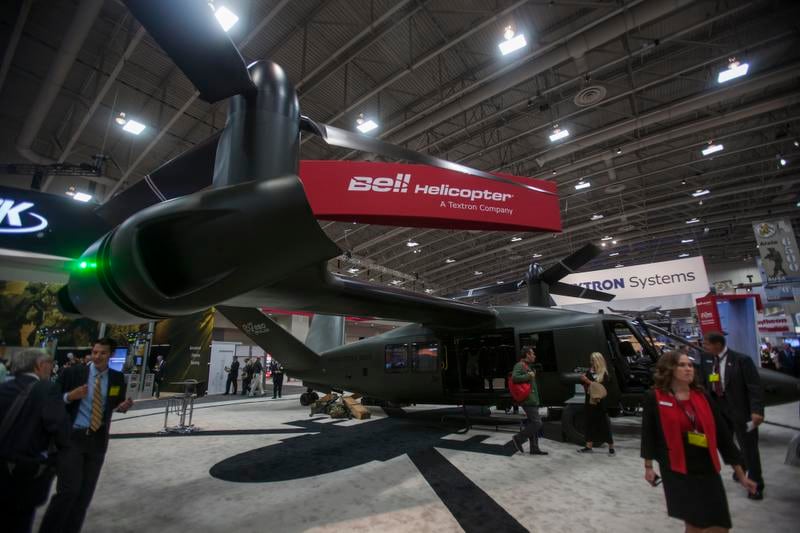ROME — A pilot school in Italy built around the M-346 jet trainer and advanced simulators — both on the ground and in the aircraft — will reach its full potential early next year, according to officials, who hope the achievement will boost the M-346’s chances in the U.S. T-X trainer contest.
With three more aircraft arriving in January, the Italian Air Force base at Lecce, southern Italy, will reach its full complement of 18 M-346s, allowing about 40 students to graduate annually from Phase IV courses before they shift to fighter squadrons.
“With the aircraft and simulators up and running, we will be at 100 percent,” base commander Col. Luigi Casali said.
Since the M-346 debuted at the school in 2014, 15 instructors have qualified to teach pilots to fly the aircraft and 13 are now training, said Casali. By mid-2018, the number of qualified instructors will rise to 18, including instructors from Italy, the Netherlands, Austria, France, Spain and the U.S.
Thirty-two student pilots have now qualified on the aircraft and 14 are now training, including three from Kuwait, added Casali.
The M-346, which is taking over Phase IV training duties from the older M-339, offers in-flight simulation of a series of capabilities, including an APG-68 radar, a targeting pod, beyond-visual-range and short-range missiles, laser- and GPS-guided bombs, a radar warning receiver, electronic warfare, and chaff and flare.
On the ground, the school has just received its second CAE full-mission simulator. And a second part task trainer, which provides an image spanning 220 degrees in azimuth and 90 degrees in vertical, is due early in the new year. The school also offers computer screen-based simulators.
RELATED

Italy's Leonardo has acted as prime contractor for the ground-based systems.
What makes Lecce unique, officials claim, is the live, virtual and constructive training capability, which allows pilots at the simulators to, in a sense, see M-346 aircraft that are actually flying, thanks to data links, and which lets the pilots of those aircraft in the air see the simulated flights through their embedded simulation capability.
Officials claim up to 10 pilots can simultaneously participate in the same flight scenario mixing real and virtual aircraft.
To complete the capability, helmet-mounted displays will be introduced for pilots in the aircraft and in the simulators next year.
“Italy is a step ahead of the U.S. in the use of this technology,” said Lt. Col. Wyatt Morrise, a U.S. Air Force F-16 pilot-turned-instructor, who is six months into a three-year stint at Lecce as part of an exchange program.
“After a flight, you have to climb out of the aircraft and remind yourself that capabilities like radar are not really there,” said Morrise, who will qualify and work as an M-346 instructor.
Morrise said that with his experience at Lecce, he hopes to help development of the syllabus for the pending U.S. T-X fighter pilot training program.
“We have a front row seat here on a syllabus, which we may be able to improve on,” he said.
The M-346, built by Italian firm Leonardo, is a contender for the TX program, alongside a new build offering from Boeing and Saab, and Lockheed Martin’s T-50.
The M-346 has been sold to Singapore, Poland and Israel, a client that officials said relies more on the aircraft and less on simulators for its training than the Italians, who now split flying hours about 50-50 between simulated and real flying.
The accent on simulators has helped the Italians reduce flying hours in the aircraft, while the embedded simulators in the aircraft have cut 30 percent from the flying hours pilots need for final training when they graduate to Italian Air Force Eurofighters, said Casali.
The next task is readying Italian pilots to fly the F-35, of which the Italian Air Force is taking delivery, with five now based at Amendola Air Base.
Hitherto, experienced Italian pilots have trained to fly the F-35 at Luke Air Force Base in the U.S., but Casali said he hopes to send the first, fresh graduates straight from Lecce to Luke next year.
“Right now we are talking to Italian F-35 pilots and instructors coming back from Luke to see how we can shape the Lecce syllabus to better prepare pilots to fly the F-35,” Casali said.
Lecce also offers Phase II and III training, which together with Phase IV training takes two years to complete. Casali said he aimed to see a total of 100 pilots qualifying from the three stages a year as the school draws in more international students, exploiting the 12,000 flying hours the base can offer annually.
The school currently has 96 students enrolled at all stages — a mix of trainee pilots and instructors that includes 50 students from other air forces. To date, the school has trained pilots from Austria, France, Kuwait and Singapore, as well as Italy.
The M-339 is still used for Phase II and III training, but the Air Force expects to take delivery of Leonardo’s new M-345 jet trainer for the job from 2020 onward.
Tom Kington is the Italy correspondent for Defense News.








